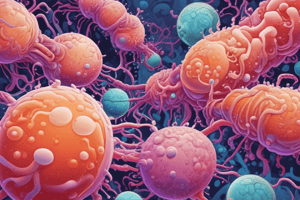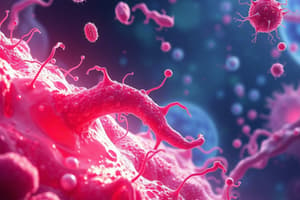Podcast
Questions and Answers
¿Cuál es la característica principal de las células bacterianas?
¿Cuál es la característica principal de las células bacterianas?
- Son eucariotas
- Son multicelulares
- No tienen un núcleo verdadero (correct)
- Tienen un núcleo verdadero
¿Qué tipo de bacterias incluye a Staphylococcus y Streptococcus?
¿Qué tipo de bacterias incluye a Staphylococcus y Streptococcus?
- Gram-positivas (correct)
- Acid-fast
- Gram-negativas
- Anaeróbicas
¿Cómo se reproducen las bacterias?
¿Cómo se reproducen las bacterias?
- Por fluorescencia
- Por mitosis
- Por fisión binaria (correct)
- Por esporulación
¿Cuál es la función principal de las bacterias en el medio ambiente?
¿Cuál es la función principal de las bacterias en el medio ambiente?
¿Qué tipo de células tienen los hongos?
¿Qué tipo de células tienen los hongos?
¿Cómo se reproducen los hongos?
¿Cómo se reproducen los hongos?
¿Qué es el micelio?
¿Qué es el micelio?
¿Qué importancia tienen los hongos en la producción de alimentos?
¿Qué importancia tienen los hongos en la producción de alimentos?
Flashcards are hidden until you start studying
Study Notes
Microbiology
Bacteriology
- Study of bacteria, a type of microorganism
- Characteristics:
- Prokaryotic cells (no true nucleus)
- Typically 0.5-5.0 μm in size
- Can be aerobic (oxygen-requiring) or anaerobic (oxygen-intolerant)
- Types of bacteria:
- Gram-positive (e.g., Staphylococcus, Streptococcus)
- Gram-negative (e.g., E. coli, Pseudomonas)
- Acid-fast (e.g., Mycobacterium)
- Bacterial growth and reproduction:
- Bacteria reproduce by binary fission
- Can form biofilms, a complex community of bacteria
- Can produce spores, a dormant form of the bacterium
- Importance of bacteria:
- Decomposition and nutrient cycling
- Production of antibiotics, vitamins, and hormones
- Pathogens causing human disease (e.g., tuberculosis, food poisoning)
Mycology
- Study of fungi, a type of microorganism
- Characteristics:
- Eukaryotic cells (true nucleus)
- Can be unicellular (yeast) or multicellular (mold)
- Obtain nutrients by decomposing organic matter or forming symbiotic relationships
- Types of fungi:
- Yeast (e.g., Candida, Saccharomyces)
- Mold (e.g., Aspergillus, Penicillium)
- Mushrooms (e.g., Agaricus, Boletus)
- Fungal growth and reproduction:
- Fungi reproduce by producing spores
- Can form mycelium, a network of branching hyphae
- Can produce fruiting bodies, such as mushrooms
- Importance of fungi:
- Decomposition and nutrient cycling
- Production of antibiotics, vitamins, and other compounds
- Pathogens causing human disease (e.g., ringworm, candidiasis)
- Used in food production (e.g., bread, beer, cheese)
Microbiología
Bacteriología
- El estudio de bacterias, un tipo de microorganismo
- Características:
- Células procariotas (sin núcleo verdadero)
- Típicamente de 0,5-5,0 μm de tamaño
- Pueden ser aeróbicas (requieren oxígeno) o anaeróbicas (intolerantes al oxígeno)
- Tipos de bacterias:
- Gram-positivas (p. ej., Staphylococcus, Streptococcus)
- Gram-negativas (p. ej., E. coli, Pseudomonas)
- Ácido-resistentes (p. ej., Mycobacterium)
- Crecimiento y reproducción bacteriana:
- Las bacterias se reproducen mediante fisión binaria
- Pueden formar biopelículas, una comunidad compleja de bacterias
- Pueden producir esporas, una forma durmiente de la bacteria
- Importancia de las bacterias:
- Descomposición y ciclo de nutrientes
- Producción de antibióticos, vitaminas y hormonas
- Patógenos que causan enfermedades humanas (p. ej., tuberculosis, intoxicación alimentaria)
Micología
- Estudio de hongos, un tipo de microorganismo
- Características:
- Células eucariotas (núcleo verdadero)
- Pueden ser unicelulares (levadura) o multicelulares (moho)
- Obtienen nutrientes descomponiendo materia orgánica o formando relaciones simbióticas
- Tipos de hongos:
- Levaduras (p. ej., Candida, Saccharomyces)
- Moho (p. ej., Aspergillus, Penicillium)
- Hongos (p. ej., Agaricus, Boletus)
- Crecimiento y reproducción fúngica:
- Los hongos se reproducen produciendo esporas
- Pueden formar micelio, una red de hifas ramificadas
- Pueden producir cuerpos fructíferos, como hongos
- Importancia de los hongos:
- Descomposición y ciclo de nutrientes
- Producción de antibióticos, vitaminas y otros compuestos
- Patógenos que causan enfermedades humanas (p. ej., tiña, candidiasis)
- Utilizados en la producción de alimentos (p. ej., pan, cerveza, queso)
Studying That Suits You
Use AI to generate personalized quizzes and flashcards to suit your learning preferences.




